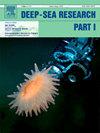海洋环境中垂直分层的证据:来自法属波利尼西亚被动声学监测的见解
IF 2.1
3区 地球科学
Q2 OCEANOGRAPHY
Deep-Sea Research Part I-Oceanographic Research Papers
Pub Date : 2025-06-21
DOI:10.1016/j.dsr.2025.104548
引用次数: 0
摘要
海洋环境中物种分布的分层现象已被广泛研究,反映了光照、温度、压力和生境结构等与深度相关的因素对海洋群落组织的影响。这项研究旨在确定这种分层是否也可以使用被动声学监测(PAM)来强调,这是一种在各种海洋栖息地研究中被证明有效的技术。2022年7月,使用SNAP声学记录器在Moorea岛(法属波利尼西亚)附近300米处记录了声音。这些数据与Moorea岛较浅深度(20、60和120米)收集的数据以及之前非同步研究中从其他波利尼西亚岛屿获得的数据进行了比较。录音中的鱼声是人工识别的。通过比较20 m至300 m深度的声音丰富度和丰度,评估高光礁、中光礁上部、中光礁下部和疏光区的鱼类群落是否可以根据它们发出的声音进行区分。在24小时的区域间比较首次揭示了声分层的存在,从高光礁到疏光礁,物种丰富度减少了四倍,同时声丰度也普遍下降。然而,这种总体模式在一天中的丰度方面并不均匀,因为黄昏时声音丰度随着深度的增加而增加,从每小时20米的950个声音增加到每小时300米的3600个声音。它进一步证实,在光照不足的地区,昼夜活动模式也很明显。这一基于鱼类声音的垂直声学分层的首次探索突出了PAM对深海群落生态学研究的不可否认的贡献。本文章由计算机程序翻译,如有差异,请以英文原文为准。
Evidence of vertical stratification in marine environments: insights from passive acoustic monitoring in French Polynesia
The stratification of species distribution in marine environments is well-documented, reflecting the influence of depth-related factors such as light availability, temperature, pressure, and habitat structure on the organization of marine communities. This study aimed to determine whether this stratification can also be highlighted using Passive Acoustic Monitoring (PAM), a technique proven effective in the study of various marine habitats. Sounds were recorded at 300 m in July 2022 off Moorea Island (French Polynesia) using a SNAP acoustic recorder. These data were compared to both those collected at shallower depths at Moorea Island (20, 60, and 120 m) and to data from other Polynesian islands obtained during a previous, non-concurrent study. Fish sounds in the recordings were manually identified. Richness and abundance of sounds from 20 m to 300 m depth were compared to assess whether fish communities in the altiphotic reef, upper mesophotic reef, lower mesophotic reef, and rariphotic zone could be distinguished based on the sounds they produce. Comparisons between zones over a 24-h period revealed for the first time the existence of acoustic stratification, with a fourfold decrease in species richness, from the altiphotic reef to the rariphotic zone, along with a general decline in sound abundance. However, this general pattern was not uniform in terms of abundance throughout the day, as sound abundance increased with depth at dusk from 950 sounds per hour at 20 m to 3600 at 300 m. It further confirms that diel activity patterns were also evident in light-deprived zones. This first exploration of vertical acoustic stratification based on fish sounds highlights the undeniable contribution of PAM to studies on the ecology of deep-sea communities.
求助全文
通过发布文献求助,成功后即可免费获取论文全文。
去求助
来源期刊
CiteScore
4.60
自引率
4.20%
发文量
144
审稿时长
18.3 weeks
期刊介绍:
Deep-Sea Research Part I: Oceanographic Research Papers is devoted to the publication of the results of original scientific research, including theoretical work of evident oceanographic applicability; and the solution of instrumental or methodological problems with evidence of successful use. The journal is distinguished by its interdisciplinary nature and its breadth, covering the geological, physical, chemical and biological aspects of the ocean and its boundaries with the sea floor and the atmosphere. In addition to regular "Research Papers" and "Instruments and Methods" papers, briefer communications may be published as "Notes". Supplemental matter, such as extensive data tables or graphs and multimedia content, may be published as electronic appendices.

 求助内容:
求助内容: 应助结果提醒方式:
应助结果提醒方式:


